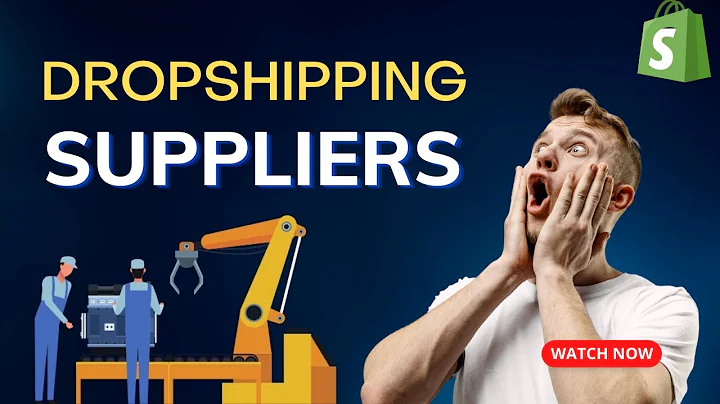Ultimate Guide to UK Dropshipping
Table of Contents:
- Introduction
- What is dropshipping?
- The Benefits of Dropshipping
- Legal Considerations for Dropshipping in the UK
- Conducting Product Research for Your UK Dropshipping Business
- Choosing the Right UK Dropshipping Suppliers
- Selecting a Selling Channel: eBay UK, Shopify UK, Wix UK
- Listing and Marketing Your Products
- Fulfilling Orders and Providing Customer Service
- Scaling and Growing Your UK Dropshipping Business
How to Start a UK Dropshipping Business: A Step-by-Step Guide
Dropshipping is a popular business model for entrepreneurs looking to start their own online stores without the hassle of inventory management. If you're interested in starting your own dropshipping business in the United Kingdom, you've come to the right place. In this guide, we'll walk you through the process of setting up a successful dropshipping business in the UK, whether you live in the UK or not.
Introduction
Starting a dropshipping business in the UK can be a lucrative venture, as the UK market is one of the largest in the world and has less competition compared to other regions like the US. In this guide, we'll cover all the necessary steps to get your UK dropshipping business up and running, from conducting product research to fulfilling orders and providing customer service. Whether you're a beginner or have some experience in dropshipping, this guide will provide you with valuable insights and strategies to help you succeed.
Chapter 1: What is Dropshipping?
Before we dive into the specifics of starting a UK dropshipping business, let's first understand what dropshipping is and how it works. Dropshipping is a business model where you sell products through your online store without actually holding any inventory. When a customer places an order, you simply forward the order details to your supplier, who then ships the products directly to the customer. As a dropshipper, you act as the middleman, earning a profit from the difference between the supplier's price and the selling price.
Chapter 2: The Benefits of Dropshipping
Dropshipping offers several advantages that make it an attractive business model. First, it requires minimal upfront investment since you don't need to purchase inventory in advance. This low barrier to entry makes dropshipping accessible to anyone with a computer and an internet connection. Additionally, dropshipping allows you to offer a wide range of products without the need for storage space or fulfillment logistics. You can also easily scale your business as there is no limit to the number of products you can sell. Furthermore, dropshipping lets you test different products and markets quickly, helping you identify profitable niches without significant risk.
Chapter 3: Legal Considerations for Dropshipping in the UK
Before starting your UK dropshipping business, it's essential to understand the legal requirements and regulations. Dropshipping is a legal business model in the UK, but you need to ensure that you follow certain guidelines. Avoid selling copyrighted or trademarked products, and familiarize yourself with the UK's business rules, including rules on preventing underage sales and online and distance selling regulations. Additionally, consider the tax obligations associated with running a dropshipping business, such as income tax, VAT, and customs duty. Consulting with a local accountant will help you understand your specific tax obligations.
Chapter 4: Conducting Product Research for Your UK Dropshipping Business
Product research is a crucial step in the success of your dropshipping business. You need to identify trending products that will resonate with your target audience and have the potential to generate sales. There are various methods you can use to conduct product research, such as exploring your supplier's website, using AliExpress's dropshipping center, leveraging the product research tool in AutoDS, and utilizing the Koala Inspector Chrome extension for Shopify and Wix. By utilizing these tools, you can discover popular, in-demand products to add to your store.
Chapter 5: Choosing the Right UK Dropshipping Suppliers
Selecting reliable UK dropshipping suppliers is essential for ensuring fast shipping times and maintaining customer satisfaction. Some popular UK dropshipping suppliers include Amazon UK, AliExpress UK, Banggood UK, Wayfair UK, Costway UK, Vita XL UK, CJ Dropshipping UK, eBay UK, Go Dropship, and Printify. Working with multiple suppliers is recommended to mitigate the risk of relying on a single supplier. Automating your dropshipping business with AutoDS can help streamline product importing, price and stock monitoring, and order fulfillment from multiple suppliers.
Chapter 6: Selecting a Selling Channel: eBay UK, Shopify UK, Wix UK
Choosing the right selling channel is crucial for reaching your target market and maximizing your sales potential. eBay UK is a user-friendly platform that offers free organic traffic and allows you to start selling with minimal customization or setup. Shopify UK and Wix UK, on the other hand, offer customizable websites with your own domain name, providing more branding opportunities. While eBay provides free traffic, Shopify and Wix require marketing efforts to drive traffic to your store. Each selling channel has its pros and cons, so consider your business needs and objectives when making a decision.
Chapter 7: Listing and Marketing Your Products
Once you have selected your selling channel, it's time to list and market your products. Listing your products involves optimizing their titles, descriptions, images, and variations to attract potential buyers. Optimizing for search engine optimization (SEO) and using relevant keywords will improve your product's visibility. Additionally, you can leverage various marketing methods such as email marketing, pay-per-click (PPC) ads, and influencer marketing to drive traffic to your store and increase sales. Implementing effective marketing strategies will help you generate brand awareness and boost your store's success.
Chapter 8: Fulfilling Orders and Providing Customer Service
As orders start coming in, it's crucial to efficiently fulfill them and provide excellent customer service. You can fulfill orders manually by purchasing the products from your suppliers' websites and shipping them to your customers' addresses. However, as your business scales, automating order fulfillment through services like AutoDS's automatic orders can save time and help prevent human errors. Additionally, customer service plays a vital role in your long-term business success. Respond promptly to customer inquiries, handle returns or issues professionally, and strive to exceed customer expectations.
Chapter 9: Scaling and Growing Your UK Dropshipping Business
Once you've established a solid foundation for your UK dropshipping business, it's time to focus on scaling and growing. To scale your business, continue conducting product research to identify new trending products and expand your product range. Explore additional selling channels, such as other marketplace platforms or your own standalone website. Invest in marketing strategies like PPC ads, social media advertising, and search engine optimization to increase your store's visibility and attract more customers. Regularly analyze your business metrics, monitor your competitors, and adapt your strategies accordingly to stay ahead in the market.
Conclusion
Starting a dropshipping business in the UK can be a lucrative venture with proper planning and execution. By following the steps outlined in this guide, you can establish a successful UK dropshipping business, whether you reside in the UK or not. Remember to conduct thorough product research, choose reliable UK dropshipping suppliers, select the appropriate selling channels, effectively market your products, fulfill orders efficiently, and provide exceptional customer service. Continuously analyzing and adapting your strategies will help you scale and grow your UK dropshipping business for long-term success.



















